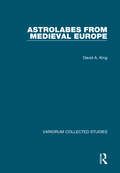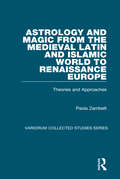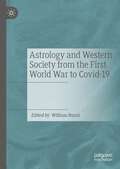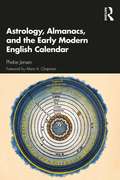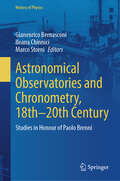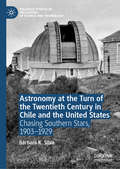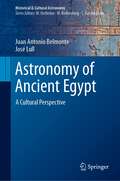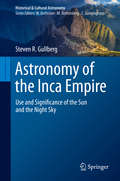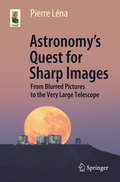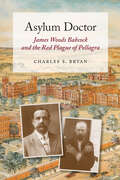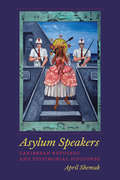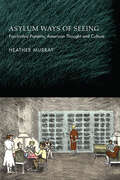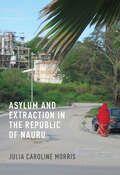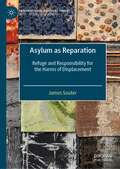- Table View
- List View
Astrolabes from Medieval Europe (Variorum Collected Studies)
by David A. KingThis is the fourth set of studies in the Variorum series by David King, a leading authority on the history of astronomy in Islamic civilization and on medieval astronomical instruments, European as well as Islamic. The first of the eleven studies collected here deals with medieval instruments in general, as precious historical sources. The following papers focus on individual astrolabes from the European Middle Ages and early Renaissance that are of singular historical importance. Two look at the origins of the simple universal horary quadrant and the complicated universal horary dial (navicula). The collection concludes with a list of all known medieval European astrolabes, ordered chronologically by region. Three "landmark" astrolabes are discussed: (1) the earliest known European astrolabe from 10th-century Catalonia, that milieu in which the astrolabe first became known to Europeans; (2) an astrolabe from 14th-century Picardy bearing numerals written in monastic ciphers as well as a later dedication mentioning two friends of Erasmus; (3) the splendid astrolabe presented in 1462 by the German astronomer Regiomontanus to his patron Cardinal Bessarion, with its enigmatic angel and Latin dedication, here presented in the context of other astrolabes of similar design from 15th-century Vienna.
Astrology and Magic from the Medieval Latin and Islamic World to Renaissance Europe: Theories and Approaches (Variorum Collected Studies)
by Paola ZambelliAstrology and Magic from the Medieval Latin and Islamic World to Renaissance Europe brings together ten of Paola Zambelli's papers on the subject, four of which are published in English for the first time. The papers in Part I of this volume deal with theories: the ideas of astrology and magic held by Renaissance thinkers; astrologers' ideas on universal history and its cycles; i.e. catastrophes and rebirths, theories; and myths regarding the spontaneous generation of man himself. Part II focuses on the role of astrologers in Renaissance society. As political counsellors, courtiers, and academics, their ideas were diffused and appreciated in both popular and high culture. Part III looks at the Great Conjunction of 1524 and on the long and extended debate surrounding it, which would not have been possible prior to Gutenberg, since astrologers printed numberless booklets (full of religious and political innuendo) predicting the catastrophe - flood, as well as earthquake or fire - foreseen for February 1524 (which, in the event, proved to be a month of extraordinary mild weather). Part IV reprints some review-articles of twentieth century scholars whose writing has contributed to our understanding of the historical problems concerning magic and other connected debates.
Astrology and Western Society from the First World War to Covid-19
by William BurnsThis book gathers contributions on the topic of astrology in the West during the twentieth and twenty-first centuries, from 1914–2022. It is the first collection exclusively devoted to a period that has been mostly neglected by historians of astrology, who have mostly devoted themselves to the ancient, medieval and early modern periods. Uninterested in vindicating or debunking astrology, contributors consider its cultural impact, its relation to historical events, and the ways in which it has changed in the last century. The broad range of subjects on modern Europe and the US include the relation of astrology with indigenous thought, interwar Polish astrology, and the relation of American astrologers to COVID. A bibliography of studies of modern astrology on a global basis is also included. This collection is a thoughtful contribution to the history of astrology and the sociology of belief as well as carrying significant implications for twentieth and twenty-first century history broadly.
Astrology in Ancient Mesopotamia: The Science of Omens and the Knowledge of the Heavens
by Michael BaigentA detailed study of the earliest forms of astrology in Mesopotamia and their far-reaching hermetic influences from the Renaissance to the present day• Reveals the roots of modern astrology in the Babylonian science of omens, which was concerned not with individuals but with the state and king• Explores Mesopotamian mythology as it relates to the planets and to astrology• Traces the hermetic transmission of this knowledge over the centuries from Mesopotamia to Egypt to Renaissance ItalyAmong the many significant discoveries excavated from Assyrian king Ashurbanipal’s royal library in Nineveh were tablets documenting the development of Mesopotamian astrology, now recognized as the earliest astrological science.Drawing upon translations of the Nineveh library tablets as well as many other ancient sources, Michael Baigent reveals the roots of modern astrology in the Babylonian science of omens. He explains how astrology in the Babylonian and Assyrian empires was concerned not with individuals but with the king and the state. He shows that by the first dynasty of Babylon, around 1900 to 1600 BC, astrology had become a systematic discipline, the preserve of highly trained specialists intent upon interpreting omens from the movements of planets and stars. He explores Mesopotamian mythology as it relates to the planets and to astrology as well as to Mesopotamian religion, magic, and politics--for the mythology of Babylon and Assyria served the state and thus changed as the state changed. He shows how this ancient form of astrology uniquely represents both Sun and Moon as masculine entities and Saturn (Ninurta) as the principle of order imposed on chaos. He examines the connections between ancient astrology and the symbolism of Western religions, such as how the “Greek” or “Templar” cross may symbolize the Babylonian god Nabu, now known as Mercury.Tracing the hermetic transmission of this knowledge over the centuries from Mesopotamia to Egypt to Florence, Baigent reveals how the religious and magical aspects of early Babylonian cosmological speculation played a significant role in the Renaissance, influencing prominent figures such as Cosimo de Medici, Marsilio Ficino, and Botticelli.
Astrology, Almanacs, and the Early Modern English Calendar
by Phebe JensenAstrology, Almanacs, and the Early Modern English Calendar is a handbook designed to help modern readers unlock the vast cultural, religious, and scientific material contained in early modern calendars and almanacs. It outlines the basic cosmological, astrological, and medical theories that undergirded calendars, traces the medieval evolution of the calendar into its early modern format against the background of the English Reformation, and presents a history of the English almanac in the context of the rise of the printing industry in England. The book includes a primer on deciphering early modern printed almanacs, as well as an illustrated guide to the rich visual and verbal iconography of seasons, months, and days of the week, gathered from material culture, farming manuals, almanacs, and continental prints. As a practical guide to English calendars and the social, mathematical, and scientific practices that inform them, Astrology, Almanacs,and the Early Modern English Calendar is an indispensable tool for historians, cultural critics, and literary scholars working with the primary material of the period, especially those with interests in astrology, popular science, popular print, the book as material artifact, and the history of time-reckoning.
Astronomer, Cartographer and Naturalist of the New World: The Life and Scholarly Achievements of Georg Marggrafe (1610-1643) in Colonial Dutch Brazil. Volume 1: Life, Work and Legacy (Studies in the History of Knowledge)
by Oscar Matsuura Huib ZuidervaartThis volume, Volume 1, presents Marggrafe's stunning biography. Volume 2 consists of a text edition of his astronomical legacy, prepared for the printing press in the 1650s, but only now finalized and published. Georg Marggrafe (1610-1643) is today hailed as the principal author of an influential account of the natural history of Northern Brazil and as compiler of the first accurate map of the area, which is considered as one of the most elegant products of seventeenth-century Dutch cartography. But initial he had the ambition to become known in astronomy. With the support Johan Maurits van Nassau-Siegen, then governor-general of colonial Dutch Brazil, he built in Recife the first European-style astronomical observatory on the South-American continent, where he systematically charted the southern stars. He intended to supplement the famous astronomer Tycho Brahe, who charted the Northern sky half a century before. But Marggrafe's untimely death (and the negligence of a Leiden professor) prevented the publication of his valuable observations. As a result, Marggrafe did not achieve fame in astronomy, but instead became famous for his equally remarkable other achievements.
Astronomer, Cartographer and Naturalist of the New World: The Life and Scholarly Achievements of Georg Marggrafe (1610-1643) in Colonial Dutch Brazil. Volume 2: Transcription and English Translation of His Astronomical Observations (Studies in the History of Knowledge)
by Huib J. Zuidervaart Oscar T. MatsuuraThis volume, Volume 2, is a supplementary text and consists of a text edition of his astronomical legacy, prepared for the printing press in the 1650s, but only now finalized and published. Volume 1 presents Marggrafe's stunning biography. Georg Marggrafe (1610-1643) is today hailed as the principal author of an influential account of the natural history of Northern Brazil and as compiler of the first accurate map of the area, which is considered as one of the most elegant products of seventeenth-century Dutch cartography. But initial he had the ambition to become known in astronomy. With the support Johan Maurits van Nassau-Siegen, then governor-general of colonial Dutch Brazil, he built in Recife the first European-style astronomical observatory on the South-American continent, where he systematically charted the southern stars. He intended to supplement the famous astronomer Tycho Brahe, who charted the Northern sky half a century before. But Marggrafe's untimely death (and the negligence of a Leiden professor) prevented the publication of his valuable observations. As a result, Marggrafe did not achieve fame in astronomy, but instead became famous for his equally remarkable other achievements.
Astronomers as Diplomats: When the IAU Builds Bridges Between Nations (Historical & Cultural Astronomy)
by Thierry Montmerle Danielle FauqueThis book illuminates a few highly significant events in history in which astronomers have helped keep contacts between astronomers of different states in moments of international political tensions or even crises. The chapters, written by 20 international authors, focus on four periods where astronomers were particularly active in international relations:1. The WWI period, the epoch of the creation of the IAU, in the context of the simultaneous creation of other scientific unions. The book also singles out the important role of A.S. Eddington and his network “across forbidden borders”.2. The Cold war period and its consequences, when several countries were divided between opposite blocs. “The China crisis” is told here from different viewpoints by Chinese astronomers, both from the mainland and from Taiwan, in parallel with the evolution of astronomy in South and North Korea. Germany’s twisted path in its membership of the IAU, from its admission in 1951 to its reunification in 1991 is shown as another example.3. The book then highlights a third period, when radio astronomers, in particular, were very active in “building bridges” between East and West. It also tells the history of how the apparently innocuous issue of the “lunar nomenclature” became extremely sensitive. The part ends on two chapters on Russian robotic missions and lunar surface features as well on the Russian participation in the “International Virtual Observatory” project.4. The fourth part reports for the first time on the “hidden story” of the relations between the IAU and the United Nations after the “Moon race” when the United Nations decided to challenge the IAU’s authority on “extraterrestrial names”. The final chapter reviews how twenty years later UNESCO and the IAU had become strong partners in the difficult, but highly successful organization of the International Year of Astronomy (2002-2009), and of the “Astronomy and World Heritage” intitiative (2008).
Astronomical Observatories and Chronometry, 18th-20th Century: Studies in Honour of Paolo Brenni (History of Physics)
by Ileana Chinnici Gianenrico Bernasconi Marco StorniThis book presents research perspectives and open questions on the intersections between astronomy and chronometry. Their study is of crucial importance to the new historiography of observatories. On the one hand, pendulums were fundamental tools for astronomical observation, as measuring time was essential to record the transit of stars and organize astrographic charts. On the other hand, astronomical observation was the method employed for time determination before the introduction of atomic clocks in the mid-20th century. Chapters of this book cohere around 5 sections: starting from the 18th century, and going through the 19th and 20th, the relations between observatories and chronometry (and more generally between practices and materiality) are analyzed from the standpoint of the quest for precision, the certification of timepieces, the acquisition and use of specific apparatus, as well as the circulation of knowledge and of instruments on a global scale.
Astronomy and Astrology in al-Andalus and the Maghrib
by Julio SamsóThis new volume of papers by Julio Samsó deals with the development of astronomy and astrology in al-Andalus and the Maghrib between the 10th and the 19th centuries. Opening with a survey of the social history of the exact sciences in al-Andalus, the book then looks at astronomical tables: the first stages of the introduction of al-Khwarizmi's and al-Battani's tables through the school of Maslama al-Majriti, the development of Ibn al-Zarqalluh/ Azarquiel's theories in Maghribi zijes (Ibn al-Banna' and Ibn Azzuz) and the abandonment of this tradition towards the end of the 14th century. From this period onwards new Eastern zijes (Muhyi al-Din al-Maghribi, Ibn al-Shatir, Ulugh Beg) are introduced in the Maghrib and, towards the beginning of the 17th century, a translation of Abraham Zacut and José Vizinho's Almanach Perpetuum (end of the 15th century) becomes well known in the whole Islamic world, from Morocco to the Yemen. As well as zijes themselves, the author also deals with theoretical astronomy (the use of an elliptical deferent for Mercury in Ibn al-Zarqalluh's equatorium and the criticisms of Ibn al-Haytham and Jabir b. Aflah on Ptolemy's determination of the parameters of the same planet), and with the use of zijes for the calculation of horoscopes, and an experimental astrological method for the correction of mean motion planetary tables (Ibn Azzuz).
Astronomy and Astrology in the Medieval Islamic World (Variorum Collected Studies)
by Edward S. KennedyThis collection of studies by Edward Kennedy looks first at questions of spherical astronomy, celestial mapping and planetary models, and then deals with astrological calculations. Throughout the author emphasises the importance of advances in mathematics for understanding the development of medieval Arabic sciences. This collection of studies based on previously unexploited manuscript sources in Arabic and Persian. They were written by authors from the 9th through the 15th centuries, whose locations reached from south China in the east through Central Asia, the Middle and Near East, and North Africa, to Spain in the west. The topics are predominately astronomical rather than astrological. The former include eclipse predictions, problems in spherical astronomy, non-ptolemaic planetary theory, and the achievements of Ulugh Beg and his observatory. Astrological subjects treated are the method of calculating the ascendant, and how to determine astrological houses and lots. An astrological history of the career of Genghis Khan is also described.
Astronomy and Culture
by Edith W. Hetherington Norriss S. HetheringtonE. Hetherington, a former second language teacher and attorney, has paired with N. Hetherington (director, Institute for the History of Astronomy) to explore the relationship between astronomy and culture throughout history in the face of contradictory attitudes from the scientific community. This book introduces the discipline of archaeoastronomy to students and scholars by reviewing ancient mythologies about the universe, revealing Babylonian concepts of astronomy, charting the development of calendars and documenting the Copernican and Newtonian Revolutions. The authors also discuss the precarious relationship between religion and astronomy such as the debate between creationism and evolution. Annotation ©2009 Book News, Inc., Portland, OR (booknews.com)
Astronomy at the Frontiers of Science (Integrated Science & Technology Program #1)
by Jean-Pierre LasotaAstronomy is by nature an interdisciplinary activity: it involves mathematics, physics, chemistry and biology. Astronomers use (and often develop) the latest technology, the fastest computers and the most refined software. In this book twenty-two leading scientists from nine countries talk about how astronomy interacts with these other sciences. They describe modern instruments used in astronomy and the relations between astronomy and technology, industry, politics and philosophy. They also discuss what it means to be an astronomer, the history of astronomy, and the place of astronomy in society today.
Astronomy at the Turn of the Twentieth Century in Chile and the United States: Chasing Southern Stars, 1903–1929 (Palgrave Studies in the History of Science and Technology)
by Bárbara K. SilvaThis Palgrave Pivot tells the transnational story of the astronomical observatory in the hills near Santiago, Chile, built in the early twentieth century through the efforts of astronomers from the Lick Observatory in California. Venturing abroad to learn from largely unmapped Southern skies and, hopefully, answer lingering questions about the structure of the galaxy, they planned a three-year research expedition—but ended up staying for more than twenty-five years. The history of the Mills Expedition offers a window onto the history of astronomy, the challenges of scientific collaboration across national lines, and the political and cultural contexts of early-twentieth-century Chile and the United States.
Astronomy in the Service of Islam (Variorum Collected Studies)
by David A. KingBased on a wide variety of previously unstudied sources, these articles explain how science was applied to three aspects of Islamic ritual in the Middle Ages: the regulation of the lunar calendar; the organisation of the times of the five daily prayers; and the determination of the sacred direction (qibla) towards the Kaaba in Mecca. Simple procedures of folk astronomy were used by the scholars of religious law who determined popular practice; more complicated mathematical methods were provided by the scientists - and this proved a powerful incentive for the development of scientific analysis and research. Some of these procedures were to have far-reaching consequences. For example, the astronomical alignment of the Kaaba - known to various medieval writers, but long forgotten - led to the adoption of similar alignments for the qibla, and the final articles show how these were calculated, whether from astronomical observation or geographical computation, and their impact on the orientation of religious and secular architecture across the Islamic world. C’est à partir d’une grande diversité de sources inexplorées que ces articles expliquent comment la science avait été appliquée a trois aspects du rituel islamique au Moyen Age: la régulation du calendrier lunaire; l’organisation des heures assignées aux cinq prières quotidiennes; et l’établissement de la direction sacrée (qibla) vers la Kaaba de la Mecque. Des procédés simples d’astronomie populaire étaient utilisés par les érudits en droit religieux qui décidaient de la pratique populaire; des méthodes mathématiques plus complexes étaient offertes par les hommes de science - ce qui, en effet, s’avèra être une motivation puissante dans le développement de l’analyse et de la recherche scientifique. Certains de ces procédés eurent des consequences d’une grande portée par la suite. L’alignement astronomique de la Kaaba - pour ne reprendre qu’un exemple connu
Astronomy of Ancient Egypt: A Cultural Perspective (Historical & Cultural Astronomy)
by Juan Antonio Belmonte José LullThis book is a comprehensive reference on ancient Egyptian astronomy, one of the most important topics in historical astronomy. Written by two recognized specialists—one an astronomer trained in Egyptology and the other an Egyptologist trained in astronomy—it synthesizes and analyses the international body of research surrounding this ancient culture.The chapters in this work address all major topics in the field, including Egyptian cosmogony and worldview, timekeeping devices and calendars, landscapes and skyscapes, astronomy-influenced architecture, chronology and more. Each chapter includes an introduction, an overview of the existing documentation on the subject, a critical discussion of ongoing debates and questions, and a presentation of state-of-the-art research.Straddling the line between Egyptology and astronomy, this multidisciplinary book will appeal to any scholar or specialist interested in studying ancient Egyptian astronomy.
Astronomy of the Inca Empire: Use and Significance of the Sun and the Night Sky (Historical & Cultural Astronomy)
by Steven R. GullbergAstronomy in the Inca Empire was a robust and fundamental practice. The subsequent Spanish conquest of the Andes region disrupted much of this indigenous culture and resulted in a significant loss of information about its rich history. Through modern archaeoastronomy, this book helps recover and interpret some of these elements of Inca civilization.Astronomy was intricately woven into the very fabric of Andean existence and daily life. Accordingly, the text takes a holistic approach to its research, considering first and foremost the cultural context of each astronomy-related site. The chapters necessarily start with a history of the Incas from the beginning of their empire through the completion of the conquest by Spain before diving into an astronomical and cultural analysis of many of the huacas found in the heart of the Inca Empire.Over 300 color images—original artwork and many photos captured during the author’s extensive field research in Machu Picchu, the Sacred Valley, Cusco, and elsewhere—are included throughout the book, adding visual insight to a rigorous examination of Inca astronomical sites and history.
Astronomy’s Quest for Sharp Images: From Blurred Pictures to the Very Large Telescope (Astronomers' Universe)
by Pierre LénaSince the 1960s, astrophysical discoveries have blossomed, due to the emergence of powerful and new observational tools. Among them, a fantastic improvement of the sharpness of astronomical images, obtained with ground based optical telescopes, has been the result of two revolutions: adaptive optics and optical interferometry. Written for a general audience, interwoven with fascinating details about the evolution of vision and optics, this book tells a personal story of these revolutions in observational astronomy, born two centuries ago and blossoming in the past fifty years. With the construction of the Very Large Telescope in Chile, Europe played a leading role where young scientists, joining creative astronomers and engineers, have developed a superb creativity. Today, incredibly sharp images of exoplanetary systems and black hole environments are obtained and reveal new questions about Earth-like objects or fundamental physics. The author has been one of the actors of this adventure. His first-hand testimony is opening the future to new horizons.
Astropolitik: Classical Geopolitics in the Space Age (Strategy and History)
by Everett C. DolmanThis volume identifies and evaluates the relationship between outer-space geography and geographic position (astrogeography), and the evolution of current and future military space strategy. In doing so, it explores five primary propositions.
Asylum Doctor: James Woods Babcock and the Red Plague of Pellagra
by Charles S. BryanThis biography of an early twentieth-century South Carolina doctor sheds light on his pioneering work with the mentally ill to combat a public health scourge.Thousands of Americans died of pellagra before the cause—vitamin B3 deficiency—was identified. Credit for solving the mystery is usually given to Dr. Joseph Goldberger of the US Public Health Service. But in Asylum Doctor, Charles S. Bryan demonstrates that a coalition of American asylum superintendents, local health officials, and practicing physicians set the stage for Golberger’s historic work—chief among them was Dr. James Woods Babcock.As superintendent of the South Carolina State Hospital for the Insane from 1891 to 1914, Babcock sounded the alarm against pellagra. He brough out the first English-language treatise on the subject and organized the National Association for the Study of Pellagra. He did so in the face of troubled asylum governance which, coupled with Governor Cole Blease’s political intimidation and unblushing racism, eventually drove Babcock from his post. Asylum Doctor describes the plight of the mentally ill in South Carolina during an era when public asylums had devolved into convenient places to warehouse inconvenient people. It is the story of an idealistic humanitarian who faced conditions most people would find intolerable. And it is important social history for, as this book’s epigraph puts it, “in many ways the Old South died with the passing of pellagra.”
Asylum Seekers and Refugees in the Contemporary World (The Making of the Contemporary World)
by David J. WhittakerExamining a number of case studies, including Palestinian, Afghan and Iraqi refugees, David J. Whittaker’s book provides a balanced introduction to this very controversial subject. Fuelled by extensive coverage in the media, the issue of asylum seekers and refugees is one of the most talked about subjects in contemporary politics. Whittaker cuts through the emotive language to give an objective introduction to the subject. Asylum Seekers and Refugees in the Contemporary World discusses the international as well as national implications of the issue, and the book looks in detail at the issue as it has affected Britain and Europe in particular, as well as including material on the UN and its response to the refugee ‘problem’. Including a final statement on the British government’s 2005 proposals for dealing with refugees, this volume is essential reading for all students of the history of the modern world and is ideal for newcomers to the subject.
Asylum Speakers: Caribbean Refugees and Testimonial Discourse
by April ShemakOffering the first interdisciplinary study of refugees in the Caribbean, Central America, and the United States, Asylum Speakers relates current theoretical debates about hospitality and cosmopolitanism to the actual conditions of refugees. In doing so, the author weighs the questions of "truth value" associated with various modes of witnessing to explore the function of testimonial discourse in constructing refugee subjectivity in New World cultural and political formations. By examining literary works by such writers as Edwidge Danticat, Nikòl Payen, Kamau Brathwaite, Francisco Goldman, Julia Alvarez, Ivonne Lamazares, and Cecilia Rodríguez Milanés, theoretical work by Jacques Derrida, Edouard Glissant, and Wilson Harris, as well as human rights documents, government documents, photography, and historical studies, Asylum Speakers constructs a complex picture of New World refugees that expands current discussions of diaspora and migration, demonstrating that the peripheral nature of refugee testimonial narratives requires us to reshape the boundaries of U.S. ethnic and postcolonial studies.
Asylum Ways of Seeing: Psychiatric Patients, American Thought and Culture
by Heather MurrayAsylum Ways of Seeing is a cultural and intellectual history of people with mental illnesses in the twentieth-century United States. While acknowledging the fraught, and often violent, histories of American psychiatric hospitals, Heather Murray also suggests that it is in these hospitals that patients became more intense observers: they gave more conscious consideration to institutional and broader kinds of citizenship, to the nature and needs of communities versus those of individuals, to scientific modernity, and to human rights and solidarities among the suffering. All of these ideas have animated twentieth-century America, and, as Murray shows, have not just flowed into psychiatric hospitals but outward from them as well. These themes are especially clear within patients' intimate, creative, and political correspondence, writings, and drawings, as well as in hospital publications and films.This way of thinking and imagining contrasts with more common images of the patient—as passive, resigned, and absented from the world in the cloistered setting of the hospital—that have animated psychiatry over the course of the twentieth century. Asylum Ways of Seeing traces how it is that patient resignation went from being interpreted as wisdom in the early twentieth century, to being understood as a capitulation in scientific and political sources by mid-century, to being seen as a profound violation of selfhood and individual rights by the century's end. In so doing, it makes a call to reconsider the philosophical possibilities within resignation.
Asylum and Extraction in the Republic of Nauru
by Julia Caroline MorrisAsylum and Extraction in the Republic of Nauru provides an extraordinary glimpse into the remote and difficult-to-access island of Nauru, exploring the realities of Nauru's offshore asylum arrangement and its impact on islanders, workforces, and migrant populations. Drawing on extensive fieldwork in Nauru, Australia, and Geneva, as well as a deep dive into the British Phosphate Commission archives, Julia Caroline Morris charts the island's colonial connection to phosphate through to a new industrial sector in asylum. She explores how this extractive industry is peopled by an ever-shifting cast of refugee lawyers, social workers, clinicians, policy makers, and academics globally and how the very structures of Nauru's colonial phosphate industry and the legacy of the "phosphateer" era made it easy for a new human extractive sector to take root on the island. By detailing the making of and social life of Nauru's asylum system, Morris shows the institutional fabric, discourses, and rhetoric that inform the governance of migration around the world. As similar practices of offshoring and outsourcing asylum have become popular worldwide, they are enabled by the mobile labor and expertise of transnational refugee industry workers who carry out the necessary daily operations. Asylum and Extraction in the Republic of Nauru goes behind the scenes to shed light on the everyday running of the offshore asylum industry in Nauru and uncover what really happens underneath the headlines. Morris illuminates how refugee rights activism and #RefugeesWelcome-style movements are caught up in the hardening of border enforcement operations worldwide, calling for freedom of movement that goes beyond adjudicating hierarchies of suffering.
Asylum as Reparation: Refuge and Responsibility for the Harms of Displacement (International Political Theory)
by James SouterThis book argues that states have a special obligation to offer asylum as a form of reparation to refugees for whose flight they are responsible. It shows the great relevance of reparative justice, and the importance of the causes of contemporary forced migration, for our understanding of states’ responsibilities to refugees. Part I explains how this view presents an alternative to the dominant humanitarian approach to asylum in political theory and some practice. Part II outlines the conditions under which asylum should act as a form of reparation, arguing that a state owes this form of asylum to refugees where it bears responsibility for the unjustified harms that they experience, and where asylum is the most fitting form of reparation available. Part III explores some of the ethical implications of this reparative approach to asylum for the workings of states’ asylum systems and the international politics of refugee protection.
